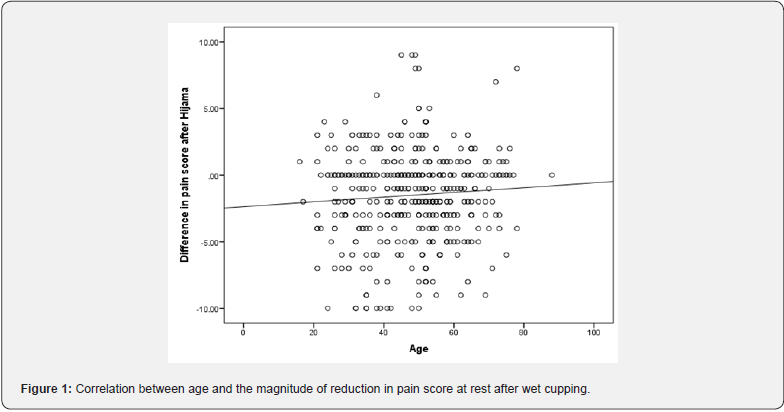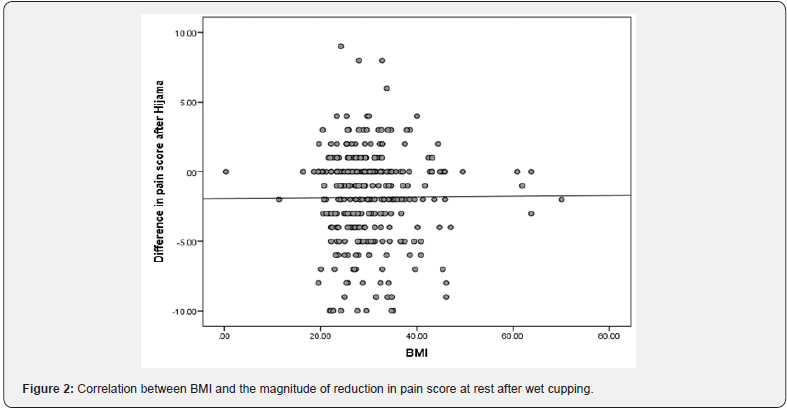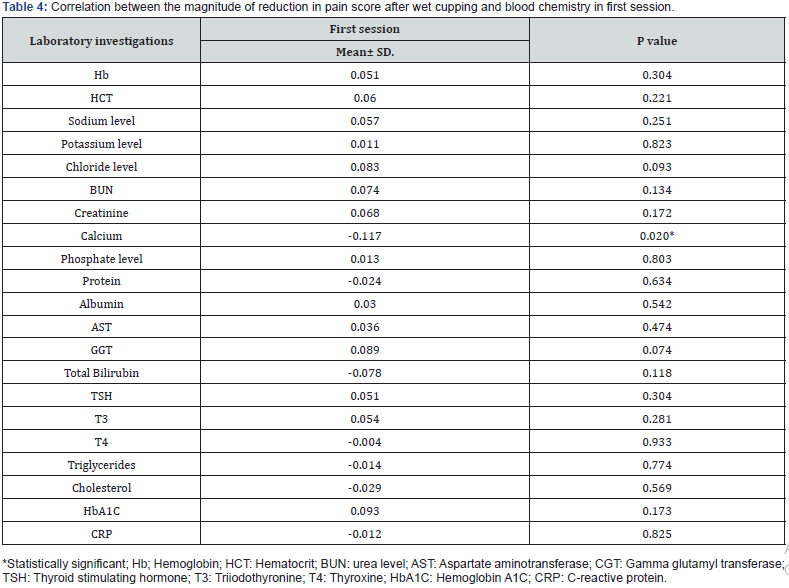Orthopedics and Rheumatology Open Access Journal - Juniper Publishers
Clinical and Biochemical Changes Among Nonspecific Low Back Pain Patients Treated with Wet Cupping Therapy: A Prospective Interventional Study
Kaki Abdullah1*, Rohaiem Sawsan2, Mourad Samiha3, Al Jaouni Soad4, Mohsen Abdul Elalah5 and Sabrin Kholey6
1Abdullah M Kaki, Consultant and Professor, Department of Anesthesia & Critical care, Faculty of Medicine, King Abdulaziz University; Consultant of Pain Medicine, ALsalama Hospital, Jeddah, Saudi Arabia
2Sawsan Rohaiem, Professor, Department of Physiology, Faculty of Medicine, King Abdulaziz University, Jeddah, Saudi Arabia
3Samiha Mourad, Cupping Clinic, King Abdulaziz University Hospital, Jeddah, Saudi Arabia
4Soad Al Jaouni, Professor of Paediatric Haematology, Department of Haematology, Faculty of Medicine, King Abdulaziz University, Jeddah, Saudi Arabia
5Mohsen Abdul Elalah, Cupping Clinic, King Abdulaziz University Hospital, Jeddah, Saudi Arabia
6Sabrin Kholey RN, Cupping Clinic, King Abdulaziz University Hospital, Jeddah, Saudi Arabia
Submission: March 30, 2024; Published: April 10, 2024
*Corresponding author: Abdullah Kaki, Department of Anaesthesia & Critical Care, Faculty of Medicine, King Abdulaziz University, Saudi Arabia
How to cite this article: Kaki Abdullah*, Rohaiem Sawsan, Mourad Samiha, Al Jaouni Soad, Mohsen Abdul Elalah and Sabrin Kholey. Clinical and Biochemical Changes Among Nonspecific Low Back Pain Patients Treated with Wet Cupping Therapy: A Prospective Interventional Study. Ortho & Rheum Open Access J. 2024; 22(5): 556105. DOI: 10.19080/OROAJ.2024.22.556105
Abstract
Background: Wet cupping is an alternative treatment option, used to treat several medical conditions. The present study aimed to assess the effect of wet cupping therapy on nonspecific low back pain with respect to both clinical and laboratory profiles.
Methods: A total of 444 patients with low back pain were included in this study. Five wet cupping sessions were performed on the bladder meridian of each patient on a monthly basis. Pre-and post-cupping assessments of low back pain were performed using a visual analogue scale, and blood samples were collected to evaluate biochemical changes.
Results: The mean age of the included patients was 47.9±13.8 years, and 76.3% were female. The baseline pain score at rest was 5.6±3.0, which reduced significantly to 2.7±2.8 after the third cupping session (p <0.05). Similarly, the average baseline pain score with activity was 4.8±3.3, which reduced significantly after the third session to 1.9±2.3. Blood chemistry analysis revealed a significant decrease in blood urea, creatinine, total protein, and albumin levels, while there was a significant increase in total cholesterol and HbA1C. The correlation between the laboratory values and the magnitude of reduction in pain score in the first session revealed that only the calcium levels exhibited an inverse significant correlation with the magnitude of reduction in pain score.
Conclusions: The results of the present study support the use of wet cupping as a therapy to relieve nonspecific low back pain as well as improve body physiology. Saudi Clinical Trial Registry no 21092302.
Keywords: Nonspecific; Low Back Pain; Wet Cupping; Clinical; Biochemical
Abbreviations: NLBP: Nonspecific Low Back Pain; Hb: Hemoglobin; Hct: Hematocrit; BUN: Blood Urea Nitrogen; HbA1C: hemoglobin A1C; ALP: Alkaline Phosphatase; AST: Aspartate Aminotransferase; ALT: Alanine Transaminase
Introduction
Chronic nonspecific low back pain (NLBP) is one of the most common health problems worldwide, with approximately 80% of the population suffering from NLBP at least once during their lifetime [1,2]. In most patients, the symptoms are not attributed to etiological or neurological causes [3]. Conventional treatments, including medications [4] and surgical interventions, [5] have demonstrated efficacy in certain groups of patients. Unfortunately, these treatment modalities are not always effective and may cause serious side effects [5,6]. For these reasons, some patients have moved towards complementary and alternative medicine [7]. Wet cupping (Hijama) is one of the traditional Chinese medicinal techniques, known for thousands of years and used to treat several medical conditions, such as pain, hypertension, and stroke [8- 10]. Despite many published articles describing the mechanisms behind the action of wet cupping and correlating it with modern medicine, we still lack a clear pathway explaining the mechanism of action of wet cupping. In this single arm prospective study, we aimed to evaluate the effect of wet cupping on low back pain and blood laboratory values among a group of patients with NLBP.
Materials and Methods
Following ethics and research committee approval (Ethics and research committee, King Abdulaziz University hospital, reference no 851-12), a prospective interventional study was conducted at King Abdulaziz University Hospital, Jeddah, Saudi Arabia, from 2014 to 2019. The study was carried out in accordance with the principles stated in the Declaration of Helsinki. Informed written consent was obtained from all patients aged 18 years and above, suffering from low back pain for 3 months or longer, diagnosed by an expert pain specialist, and referred to the cupping clinic upon their request to try alternative and complementary therapy.
Pregnant, lactating women; patients with mental or psychological illnesses; patients using opioids or psychotropic medications; patients with local infection at the site of cupping; cancer patients; patients with chronic renal, hepatic, or cardiac diseases; patients with hematological diseases or using anticoagulants; and patients who complained of other acute or chronic pain conditions were excluded from the study. Baseline measurements were performed three days prior to the performance of wet cupping, and further samples were obtained one week after each cupping procedure for three consecutive sessions. Blood samples were collected after 12 hours of fasting from every patient to assess biochemical changes following wet cupping therapy. Data were collected by a research assistant interviewing the patient at each visit using a well-structured questionnaire. The questionnaire contained two parts: the first part dealt with demographic data, anthropometric data, and comorbidities, while the second part of the questionnaire covered the assessment of pain using the visual analogue scale. Data was collected prior to cupping session and one week after the intervention. This process was repeated for each session. Any complications resulting from the cupping procedure were documented.
The visual analogue scale (VAS) for pain assessment ranges from 0 to 10 cm, with 0 indicating no pain and 10 indicating the worst pain imaginable. This scale was explained to the patient, and baseline values were obtained before the performance of the procedure, both at rest and during activity, and repeated after each session monthly for 4 consecutive months. Cupping was performed by an expert therapist using sterile disposable plastic cups, placed bilaterally at the bladder meridians (BL 23, BL 24, and BL 25) according to the World Health Organization guidelines for acupuncture point locations [11,12]. Skin sterilization was performed, and slight skin laceration was performed using a sterile 22-gauge surgical lancet followed by application of plastic cups to the bloodletting points and suction was activated. Bleeding from the dermal microcirculation was initiated by reapplying the plastic cups on the skin scarification points to encourage bloodletting. After 5-10 minutes when the blood in the cup became solid, the cup with the blood was removed, the skin was cleaned with alcohol, and covered with gauze for 24 hours. Blood samples were collected as a baseline prior to cupping and repeated monthly following the second and third sessions. The obtained blood samples were evaluated for hemoglobin (Hb) concentration, hematocrit (Hct) values, electrolyte levels, calcium, blood urea nitrogen (BUN) and creatinine levels. In addition to the above, liver function test, thyroid function test, hemoglobin A1C (HbA1C) assessment, and lipid profile analysis were also performed.
Statistical Analysis
Given that research on wet cupping is limited, a pilot study was conducted to estimate the sample size. Considering 80% as an acceptable power to detect the difference in VAS pain score with 95% confidence (significance set at p value < 0.05), a sample size of 47 patients was found to be appropriate. All data analyses were performed using the Statistical Package for the Social Sciences (version 22.0; IBM Corporation, Armonk, NY, USA). Participant demographic data were analyzed using descriptive statistics. The Wilcoxon signed-rank test was used to analyze pain scores, as pain score is an ordinal variable and the readings obtained were paired, that is, each patient had two readings, one before and one after the cupping procedure.
Results
A total of 444 patients with NLBP were assessed for severity of pain using VAS before being subjected to wet cupping and repeated after each session of the procedure. Pain scores were recorded at rest and during activity. Most of the patients were women (76.3%) and the mean age of participants was 47.9±13.8 years, ranging between 18-88 years with no statistically significant differences between females (48.3±13.0 years) and males (46.7±16.0 years). The mean BMI was 30.0±7.8. At baseline, before starting wet cupping, the average pain score at rest was 5.6±3.0, which was reduced significantly after the first session to an average of 4.1±3.2. The same was observed after the second and third sessions, where the average pain score decreased from 4.7±4.2 to 3.2±3.0 in the second session, and from 4.6±3.5 to 2.7±2.8 in the third session (p <0.05).
Meanwhile, it was found that although the average pain scores were reduced in the fourth and fifth sessions, these reductions were not statistically significant (p >0.05) (Table 1). Similarly, it was found that the average pain score with activity at the baseline before starting wet cupping was 4.8±3.3, which was reduced significantly after the first session to an average of 2.9±2.5. Further reduction was noted in the second session from 3.6±3.0 to 2.2±2.4, and in the third session, there was a reduction from an average of 3.4±3.1 down to 1.9±2.3 (p <0.05). Meanwhile, the reduction in the average pain scores in the fourth and fifth sessions was not statistically significant (p >0.05) (Table 2). Although the average reduction in pain score was found to be higher among females (1.6±3.5) than males (1.1±3.1), this difference was not statistically significant (p >0.05).



Meanwhile, as shown in Figure 1, the magnitude of reduction in pain score was higher among young patients and decreased with age; nevertheless, this inverse correlation was not statistically significant (p >0.05). Similarly, there was no correlation between BMI and the magnitude of pain reduction, as shown in Figure 2. Blood chemistry analysis was carried out for all patients during the first three sessions, and Table 3 shows the changes in the laboratory readings following wet cupping. There was significant decrease in BUN, creatinine, total protein, and albumin, while there was a significant increase in cholesterol level and HbA1C (p <0.05). The correlation between the laboratory parameters and the magnitude of reduction in pain score after the first session showed that only calcium level exhibited an inverse significant correlation with the magnitude of reduction in pain score (Table 4). No complications were reported in any of the patients.



Discussion
The main finding of our study is the significant reduction in NLBP as well as the reduction in the readings of blood laboratory values following the performance of multiple sessions of wet cupping. The relief in lower back pain after wet cupping therapy has been documented in many of the previously published studies [13-18]. Although the number of wet cupping sessions carried out were different among these studies, the positive effect of wet cupping on low back pain was the same.
In our study, reduction in VAS score was noticed after the 4th and 5th sessions of wet cupping, both at rest and with activity, but it was not significant and further investigation is needed to clarify the underlying mechanism and exclude any contributing factors. We observed a significant reduction in the levels of BUN, creatinine, total protein, and albumin, while there was a significant increase in cholesterol and HbA1C levels following wet cupping. When the laboratory changes were correlated with the changes in pain after the first session of wet cupping, calcium levels exhibited an inverse relationship with the reduction in pain score. Husain et al. reported similar changes in biochemical profile in 31 healthy adults and reported a significant reduction in serum urea and creatinine levels following wet cupping therapy, while the fasting blood sugar was found to be lower at one, three, and four months after therapy when compared to baseline [19].
The changes in blood sugar are opposite to our finding, where HbA1C increased with repetitive sessions of wet cupping. In a study by Al showafi, venous blood samples of 30 healthy subjects were collected 10 days after wet cupping and a significant decrease in serum creatinine, cholesterol, triglyceride, and lowdensity lipoprotein with an increase in the serum high-density lipoprotein were documented; meanwhile, the effect on urea and blood glucose was not significant [20]. Ranaei-siadat et al. used a similar study design with a smaller sample of healthy subjects and showed a regulatory effect of wet cupping on fasting blood sugar and cholesterol, while no positive effect was reported on liver function test, renal profile, thyroid profile, calcium, Hb, or Hct [21]. Mashlool and Aowada showed a significant decrease in blood sugar levels post cupping compared to the pre-cupping in 100 volunteers. A significant increase in albumin level was reported when compared to the pre-cupping level [22].
In another study, Abbas et al. observed a significant increase in red blood cell number after cupping and a significant decrease in Hct, Hb, platelets, neutrophils, and lymphocytes. Cholesterol levels, as well as low-density lipoprotein and triglycerides were found to be lower. Liver enzyme alkaline phosphatase (ALP), creatinine, BUN, and blood glucose levels decreased as well, while total protein, aspartate aminotransferase (AST), and alanine transaminase (ALT) increased after wet cupping. Serum electrolyte levels showed a significant decline in serum calcium ion levels [23]. A similar finding regarding calcium levels was found in our study, but it was statistically insignificant. Looking at the designs of these studies, the sample sizes, the assessment tools, and the cultural background of the involved subjects, we might find an explanation for the reported differences in the results. Some studies have reported findings that are consistent with our findings, while others have reported contrary results; however, the general consensus is that there is a significant decrease in creatinine, urea, and albumin levels. While fasting and random blood sugar levels were decreased in previous studies, HbA1C levels increased in our study. Unfortunately, none of the studies excluded the effects of exercise, diet, nutritional status, physical and emotional status of the subjects. Thus, further studies are needed to estimate the effect of wet cupping on biochemical profile after considering all these factors.
Although the changes in calcium level were not statistically significant, there was an inverse relationship between the level of calcium and pain relief after the first session of wet cupping. The exact mechanisms behind the development of chronic pain remains unclear and may depend on the type of pain and the initiating causes but there is considerable evidence pointing towards the role of intracellular calcium in the development of persistent pain. Calcium-permeable ion channels and receptors have been implicated in the initiation of pain, as well as neuroplasticity [24-27]. The inverse relationship between the level of calcium and pain relief might be one of the mechanisms behind the positive effect of wet cupping on pain. More clinical trials are needed in the future to confirm this relationship.
Study Limitations
One of the limitations of the present study was the absence of a control group. The second limitation is the difficulty in differentiating the effect of wet cupping from the placebo effect, Lastly, the effect of other environmental factors that alter the body physiology and might contribute to the changes in the laboratory measurements is another limitation of the study.
Conclusion
The results of the present study support the use of wet cupping to relieve NLBP and regulate certain physiological parameters. Further studies with a larger sample size and better design are needed to confirm the effects of wet cupping on various body functions.
To Know more about our Juniper PublishersJuniper Publishers
Click here: https://juniperpublishers.com/index.php





No comments:
Post a Comment